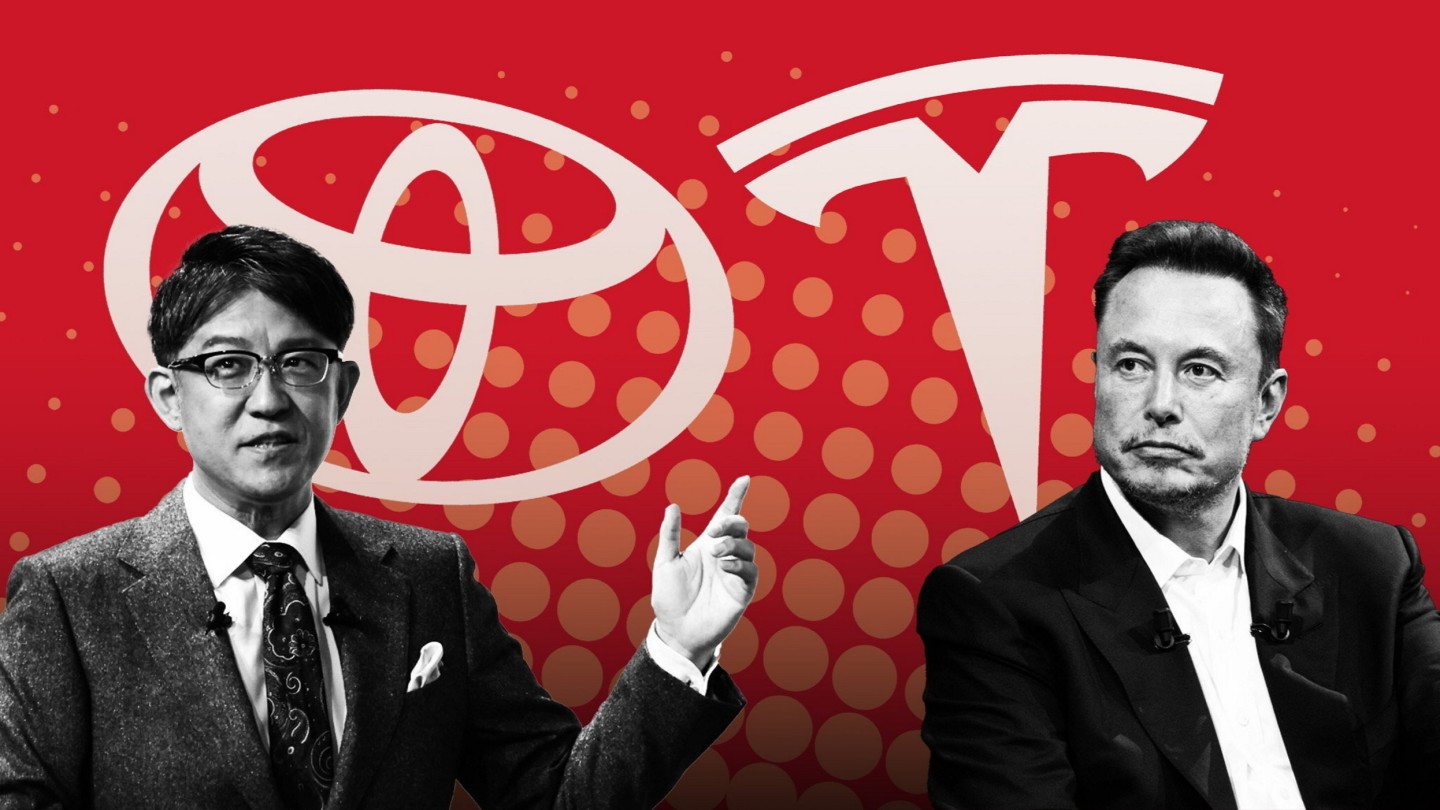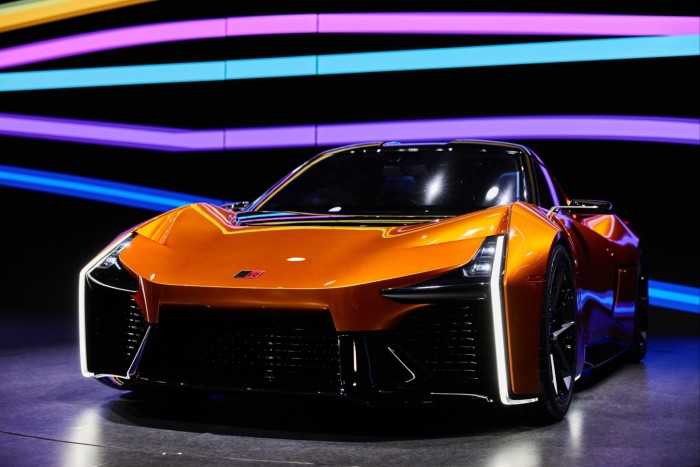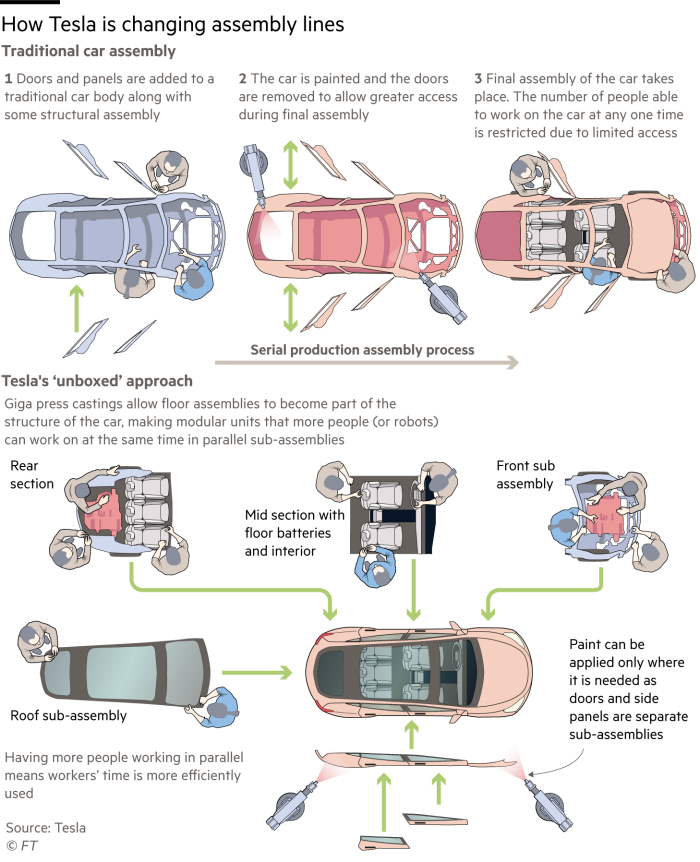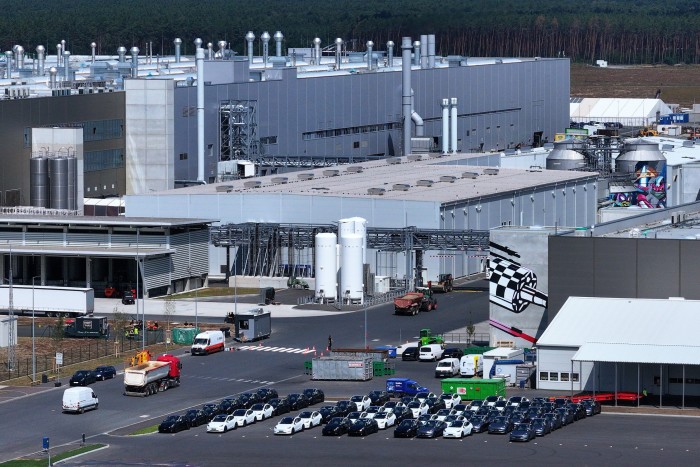Toyota takes on Tesla’s gigacasting in battle for carmaking’s future

Simply sign up to the Electric vehicles myFT Digest -- delivered directly to your inbox.
Toyota’s battle to catch up with Tesla in a new era of electric vehicles is playing out in one of the oldest parts of the carmaking business: the assembly line.
The Japanese carmaker has been claiming technology breakthroughs in solid-state batteries and last week placed an $8bn bet on the US electric vehicle market as it tries to persuade investors of its ability to compete with Tesla.
But Toyota is also being challenged by Tesla on the factory floor, where the world’s most valuable carmaker is pioneering a fundamental change to the way cars are made. Tesla chief executive Elon Musk argues that legacy assembly processes need to be changed for battery-powered vehicles, simplifying and speeding up carmaking with fewer suppliers and vehicle models.
Some car executives and analysts expect Tesla’s process — which Musk calls “gigacasting” — to set a new benchmark for building vehicles, replacing the vaunted Toyota Production System based on just-in-time manufacturing efficiency.
“The way Toyota builds cars has been considered the standard but it’s extremely shocking to think that what Tesla is proposing is likely to become the standard for producing EVs. The impact on Japan’s car manufacturing will be monumental,” said Takaki Nakanishi, a veteran automotive analyst who runs his own research group.

It leaves Koji Sato, Toyota’s new 54-year-old president, fighting to show that his company’s well-honed methods for producing millions of vehicles each year in multiple configurations will remain a competitive advantage in the electric vehicle era.
The way Tesla is making cars “is quickly moving to become an industry standard”, said one senior executive at a European automaker.
Tesla has been using gigacasting as a manufacturing method for its Model Y sport utility vehicle since 2020. Musk has said he first had the idea after looking at his child’s die-cast toy cars — and wondering why that could not be replicated for the real thing.
Traditionally, the main body of a car has been made by welding or stamping together a large number of separate parts. Gigacasting or megacasting, on the other hand, uses casting machines to force molten metal into moulds under high pressure to produce large aluminium body parts, such as the entire underside of a vehicle.

The industry has been using casting for years for smaller aluminium components, but Musk’s plan to make whole car bodies using the technology has forced other carmakers to think bigger. Tesla did not respond to a request for comment.
“Megacasting is the perfect example of where you can replace 100 parts with just one,” said Erik Severinson, head of strategy at Volvo Cars.
This saves time, labour, cost and factory space, replacing multiple robots that weld car parts together with a single machine. The cost of changing hundreds of parts means carmakers typically produce a vehicle for 14 years, with modest changes half way through its life cycle. Casting would change this timeframe and allow carmakers to refresh their line-ups more quickly.
Gigacasting using aluminium is also one response to the way that massively heavy auto batteries are reshaping how cars are designed.
“Battery tech is driving gigacasting tech. You have to produce a lighter vehicle and for that you need a lighter body in order to improve the driving distance,” said Kota Yuzawa, a Goldman Sachs analyst in Tokyo.
While aluminium costs more than steel, “if you combine all of the elements, the cost structure should be flattish or slightly better, but in terms of performance the gigacasting is clearly better,” said Yuzawa.
The rest of the industry is taking notice. Volvo will integrate casting into its third generation of electric vehicles later this decade. General Motors chief executive Mary Barra said this year that the company had ordered two “giga press” machines with the intention of using the technology for mass-market vehicles.
Toyota, too, is working on the same technique as it aims for a massive ramp-up of EV production. During a series of plant tours in September its executives admitted that there was much to learn from Tesla and other EV manufacturers in China.
But Toyota has signalled that it does not intend to adopt the Tesla approach to gigacasting wholesale, relying instead on its decades of experience to find its own approach.
“To be honest, we are behind in gigacasting since we have yet to roll out a product,” Kazuaki Shingo, Toyota’s chief production officer, told analysts and investors. “But we have done casting for a long time . . . and ultimately we believe we can produce a product that will be cheaper, lighter and thinner with high performance.”

By adopting gigacasting and using new assembly lines, Toyota will aim to cut processes and plant investment by half.
But executives are wary of producing vehicles with a single moulded underbody. As things stand, changing one damaged part in a vehicle is relatively cheap and easy. If the whole underside had to be replaced, it would lead to a significant rise in the number of vehicles deemed too costly to repair.
Manufacturing experts agree this is potentially a major drawback of the technology. “The big question is how many cars being made with [gigacasting] have to be written off to make it not worth using,” said one automotive manufacturing expert who advises Toyota and other carmakers.
Toyota is considering whether producing an underbody in several pieces could reduce repair and insurance costs — potentially important factors for an automaker with a much wider global market than Tesla.
Toyota, the world’s biggest carmaker by annual unit sales, has laid out plans to sell 3.5mn battery powered vehicles every year from 2030. But this year it still only expects to sell 123,000 pure EVs in this full fiscal year, compared to an overall vehicle sales target of 11.4mn.
The carmaker has said it remains committed to what it calls “a multi-pathway approach” that relies on a broad variety of cars sold across more than 170 countries, including many where EVs might remain unaffordable for years to come.
“We don’t actually think that our 10mn vehicles will immediately shift to gigacast,” Shingo said, saying the carmaker wanted to boost productivity as a whole by mixing legacy production lines with new EV manufacturing methods.
For the moment, Toyota says it wants more than half of its 2030 sales target to be made up of EVs using its new modular architecture, which allows it to produce multiple different models, that share key components, on the same platforms.
No part of Toyota’s new tech push has received as much attention as the batteries, including solid-state, that its engineers are developing in-house.
But analysts and Toyota’s own executives suspect the changes wrought to assembly lines in response to the demands of battery technology could be just as important.
“I think those are the areas where the differences will emerge . . . and I hope these activities will help us to come ahead,” said Akihisa Shirao, general project manager of the Toyota business unit overseeing EV factory strategy.
Yuzawa said: “Gigacasting is going to reshape the whole underbody supply chain network.”
Comments